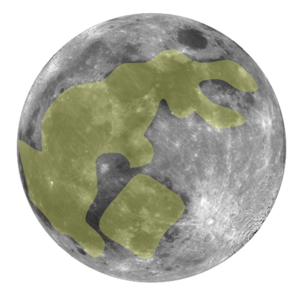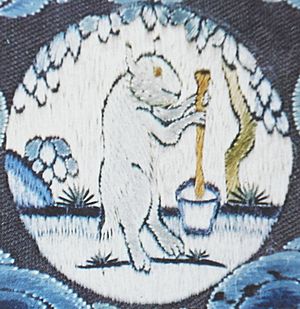Moon rabbit facts for kids
Quick facts for kids Moon rabbit |
|||||||||||
|---|---|---|---|---|---|---|---|---|---|---|---|
| Moon rabbit | |||||||||||

The image of a rabbit and mortar delineated on the Moon's surface
|
|||||||||||
| Chinese name | |||||||||||
| Chinese | 月兔 | ||||||||||
| Literal meaning | Moon rabbit/hare | ||||||||||
|
|||||||||||
| Alternative Chinese name | |||||||||||
| Chinese | 玉兔 | ||||||||||
| Literal meaning | Jade rabbit/hare | ||||||||||
|
|||||||||||
| Vietnamese name | |||||||||||
| Vietnamese alphabet | thỏ ngọc | ||||||||||
| Chữ Hán | 玉兔 | ||||||||||
| Korean name | |||||||||||
| Hangul | 달토끼 | ||||||||||
|
|||||||||||
| Japanese name | |||||||||||
| Kanji | 月の兎 | ||||||||||
|
|||||||||||
The Moon rabbit or Moon hare is a mythical figure in East Asian and indigenous American folklore, based on pareidolic interpretations that identify the dark markings on the near side of the Moon as a rabbit or hare. In East Asia, the rabbit is seen as pounding with a mortar and pestle, but the contents of the mortar differ among Chinese, Japanese, Korean and Vietnamese folklore. In Chinese folklore, the rabbit is often portrayed as a companion of the Moon goddess Chang'e, constantly pounding the elixir of life for her and some show the making of cakes or rice cakes; but in Japanese and Korean versions, the rabbit is pounding the ingredients for mochi or some other type of rice cakes; in the Vietnamese version, the Moon rabbit often appears with Hằng Nga and Chú Cuội, and like the Chinese version, the Vietnamese Moon rabbit also pounding the elixir of immortality in the mortar. In some Chinese versions, the rabbit pounds medicine for the mortals and some include making of mooncakes. Moon folklore from certain Amerindian cultures of North America also has rabbit themes and characters.
History
An early Chinese source called the Chu Ci, a Western Han anthology of Chinese poems from the Warring States period, notes that along with a toad, there is a hare on the Moon who constantly pounds herbs for the immortals. This notion is supported by later texts, including the Song-era Taiping Imperial Reader. As rabbits were not yet introduced to China during Western Han, the original image was not a rabbit but a hare.
Han Dynasty poets call the hare on the Moon the "Jade Hare" (玉兔) or the "Gold Hare" (金兔), and these phrases were used often, in place of the word for the Moon. A famous poet of Tang China, Li Bai, relates how "The rabbit in the moon pounds the medicine in vain" in his poem, "The Old Dust".
Asian folklore

In the Buddhist Jataka tales, Tale 316 relates that a monkey, an otter, a jackal, and a rabbit resolved to practice charity on the day of the full moon (Uposatha), believing a demonstration of great virtue would earn a great reward. When an old man begged for food from them, the monkey gathered fruits from the trees and the otter collected fish, while the jackal found a lizard and a pot of milk-curd. Knowing only how to gather grass, the rabbit instead offered its own body by throwing itself into a fire the man had prepared. However, the rabbit was not burnt and the old man revealed that he was Śakra. Touched by the rabbit's virtue, he drew the likeness of the rabbit on the Moon for all to see. It is said the lunar image is still draped in the smoke that rose when the rabbit cast itself into the fire. The rabbit is believed to be a Bodhisattva.
A version of this story may be found in the Japanese anthology, Konjaku Monogatarishū, where the rabbit's companions are instead a fox and a monkey.
The Moon rabbit legend is popular and part of local folklore throughout Asia. It may be found in diverse cultures in China, Japan, India, Korea, Sri Lanka, Cambodia, Thailand, Vietnam, and Myanmar.
This legend also gave rise to the Mid-Autumn Festivals of China, Tết Trung Thu of Vietnam, Tsukimi of Japan, and Chuseok of Korea, Sampeah Preah Khae in Cambodia, all of which celebrate the legend of the Moon rabbit. In Vietnamese mythology, the Jade Rabbit on the Moon is often accompanied by the Moon Lady and Cuội, who sits under a magical banyan. The trio has become the personifications of the holiday, when they descend to the mortal world and give out cellophane lanterns, mooncakes and gifts to children.
North American folklore
Presumed to be arising likewise, through lunar pareidolia, legends of Moon rabbits also exist among some indigenous cultures of North and Central America.
In Mayan art, glyphs, hieroglyphics, and inscriptions, a rabbit frequently is shown with the Moon Goddess and another deity related to the Moon.
According to an Aztec legend, the god Quetzalcoatl, then living on Earth as a human, started on a journey and, after walking for a long time, became hungry and tired. With no food or water around, he thought he would die. Then a rabbit grazing nearby offered herself as food to save his life. Quetzalcoatl, moved by the rabbit's noble offering, elevated her to the Moon, then lowered her back to Earth and told her, "You may be just a rabbit, but everyone will remember you; there is your image in light, for all people and for all times."
Another Mesoamerican legend tells of the brave and noble sacrifice of Nanahuatzin during the creation of the fifth sun. Humble Nanahuatzin sacrificed himself in fire to become the new sun, but the wealthy god Tecciztecatl hesitated four times before he finally set himself alight to become the Moon. Due to Tecciztecatl's cowardice, the deities felt that the Moon should not be so bright as the Sun, so one of the deities threw a rabbit at his face to diminish his light. Another version of the legend says that Tecciztecatl was in the form of a rabbit when he sacrificed himself to become the Moon, casting his shadow there.
In Canada and the United States, a Cree cultural legend tells a different story, about a young rabbit who wished to ride the Moon. Only the crane was willing to take him there. The trip stretched the crane's legs as the heavy rabbit held them tightly, leaving them elongated as the legs of all cranes are now. When they reached the Moon, the rabbit touched the crane's head with a bleeding paw, leaving the red mark cranes wear to this day. According to the legend, on clear nights, Rabbit still may be seen riding the Moon.
See also
- List of fictional rabbits and hares
- Lunar pareidolia
- Man in the Moon
- Rabbits and hares in art
- Rabbits in culture and literature
- Tecciztecatl
- Tu'er Ye
- Lunar mare



